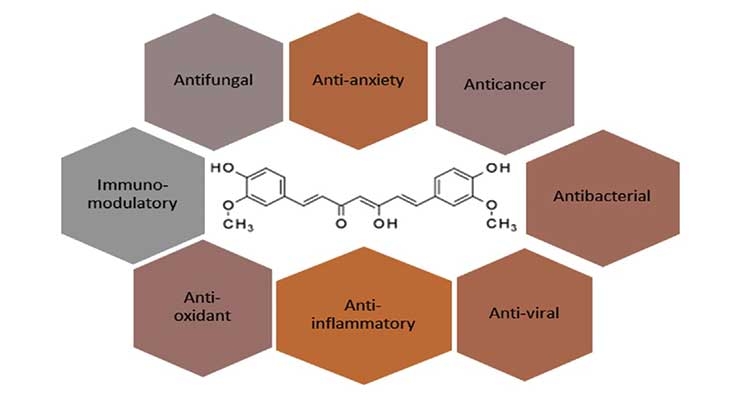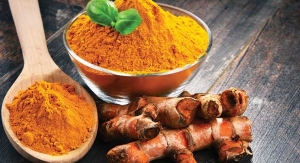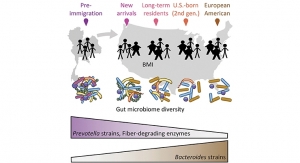By Dilip Ghosh, PhD, FACN, nutriConnect05.02.19
Turmeric is a well known spice and ancient herbal medicine from the rhizome of Curcuma longa, a member of the ginger family. Turmeric contains 3-6% curcumin in which a mixture of three naturally occurring curcuminoids are found: diferuloylmethane, desmethoxycurcumin, and bisdemethoxycurcumin. Curcumin is a multifunctional phytochemical that has documented antioxidant, anti-inflammatory, and anti-tumor properties, along with many other physiological benefits (Figure 1).
Exponential Market Growth
Due to its well documented and publicized health messages, the anti-inflammatory and antioxidant properties of curcumin make it an ideal ingredient in food/beverage, dietary supplement, cosmetic, and pharmaceutical applications.
The global curcumin market is expected to reach $130.7 million by 2025, according to a report by Grand View Research, Inc., registering a 13.3% CAGR during the forecast period. Allied Market Research, meanwhile, valued the global curcumin market at $52.45 million in 2017, and projected it will reach $104.19 million by 2025, registering a CAGR of 8.9% from 2018 to 2025.
Increasing demand for curcumin-based dietary supplements has driven the market overall. Yet, in 2017, the pharmaceutical segment accounted for more than 50% share of the global curcumin market in terms of value, according to vAllied Market Research.
Key players in the global curcumin market include Arjuna Natural Extracts Ltd., OmniActive Health Technologies, Synthite Industries Ltd., Sabinsa Corporation, Wacker Chemie, and others. Tilman SA (Belgium) has a patent for a curcumin formulation with strong clinical trials, making it a prominent player as well.
Potency & Bioavailability
Curcumin treatments have shown diverse actions based on cell type. While it acts as a cytoprotective and antioxidant agent (survival) for normal cells, it promotes oxidative damage and apoptosis (cell death) in malignant cells.
Low bioavailability of curcumin has been a limitation for clinical application due to poor absorption, water solubility, and chemical stability, as well as rapid metabolism and systemic elimination. These problems have been overcome in part by using carrier molecules and designing novel delivery systems. The use of adjuvants, liposomes, phospholipid complexes, and the development of nano formulations have enhanced the bioavailability and bioactivity of curcumin.
One unique bio-optimized formulation showed 1,350 times higher bioavailability than turmeric powder and was 538 times more soluble compared to a competitor formulation (Flexofytol, from Tilman.
OmniActive’s unique encapsulated product, CurcuWIN, using the company’s UltraSOL technology, increased relative absorption of total curcuminoids 46 times more than standard curcumin in a well-controlled human clinical trial.
It has also been demonstrated that gut microbiota has an important effect on bio-absorption of dietary polyphenols or other phytochemicals through the gut.
Beyond Anti-Inflammation & Antioxidant Effect
Most of the initial clinical studies have focused on the anti-inflammatory and anti-oxidative effects of curcumin. But during the past few years, several lines of investigation have demonstrated the dissociation of curcumin’s effect from its anti-inflammation functions via insulin signaling improvement.
A group of scientists have shown that curcumin intervention regulates both the production and sensitivity of the hepatic hormone fibroblast growth factor 21 (FGF21). Additionally, curcumin increases energy expenditure in mouse models, either by facilitating white adipose tissue “browning,” or by stimulating brown adipocyte UCP1 expression, dissociated from its anti-inflammation functions.
The extremely low absorption rate in the gut has forced scientists to rethink the true functionalality of chemical entities of curcumin that exert in vivo function. This concern has been addressed by recent studies on the interaction of polyphenols with the gut microbiota (Anhe, 2017).

References
Dilip Ghosh, PhD, FACN, is director of nutriConnect, based in Sydney, Australia. He is also professionally involved with NICM, Western Sydney University, Australia, and is an Honorary Ambassador with the Global Harmonization Initiative (GHI). Dr. Ghosh received his PhD in biomedical science from University of Calcutta, India. He has been involved in drug development (both synthetic and natural) and functional food research and development both in academic and industry domains. Dr. Ghosh has published more than 90 papers in peer-reviewed journals, and he has authored many books, including: “Biotechnology in Functional Foods and Nutraceuticals,” “Innovation in Healthy and Functional Foods,” “Clinical Perspective of Functional Foods and Nutraceuticals,” and “Pharmaceuticals to Nutraceuticals: A Shift in Disease Prevention under CRC Press. He can be reached at dghosh@optusnet.com.au; www.nutriconnect.com.au.
Exponential Market Growth
Due to its well documented and publicized health messages, the anti-inflammatory and antioxidant properties of curcumin make it an ideal ingredient in food/beverage, dietary supplement, cosmetic, and pharmaceutical applications.
The global curcumin market is expected to reach $130.7 million by 2025, according to a report by Grand View Research, Inc., registering a 13.3% CAGR during the forecast period. Allied Market Research, meanwhile, valued the global curcumin market at $52.45 million in 2017, and projected it will reach $104.19 million by 2025, registering a CAGR of 8.9% from 2018 to 2025.
Increasing demand for curcumin-based dietary supplements has driven the market overall. Yet, in 2017, the pharmaceutical segment accounted for more than 50% share of the global curcumin market in terms of value, according to vAllied Market Research.
Key players in the global curcumin market include Arjuna Natural Extracts Ltd., OmniActive Health Technologies, Synthite Industries Ltd., Sabinsa Corporation, Wacker Chemie, and others. Tilman SA (Belgium) has a patent for a curcumin formulation with strong clinical trials, making it a prominent player as well.
Potency & Bioavailability
Curcumin treatments have shown diverse actions based on cell type. While it acts as a cytoprotective and antioxidant agent (survival) for normal cells, it promotes oxidative damage and apoptosis (cell death) in malignant cells.
Low bioavailability of curcumin has been a limitation for clinical application due to poor absorption, water solubility, and chemical stability, as well as rapid metabolism and systemic elimination. These problems have been overcome in part by using carrier molecules and designing novel delivery systems. The use of adjuvants, liposomes, phospholipid complexes, and the development of nano formulations have enhanced the bioavailability and bioactivity of curcumin.
One unique bio-optimized formulation showed 1,350 times higher bioavailability than turmeric powder and was 538 times more soluble compared to a competitor formulation (Flexofytol, from Tilman.
OmniActive’s unique encapsulated product, CurcuWIN, using the company’s UltraSOL technology, increased relative absorption of total curcuminoids 46 times more than standard curcumin in a well-controlled human clinical trial.
It has also been demonstrated that gut microbiota has an important effect on bio-absorption of dietary polyphenols or other phytochemicals through the gut.
Beyond Anti-Inflammation & Antioxidant Effect
Most of the initial clinical studies have focused on the anti-inflammatory and anti-oxidative effects of curcumin. But during the past few years, several lines of investigation have demonstrated the dissociation of curcumin’s effect from its anti-inflammation functions via insulin signaling improvement.
A group of scientists have shown that curcumin intervention regulates both the production and sensitivity of the hepatic hormone fibroblast growth factor 21 (FGF21). Additionally, curcumin increases energy expenditure in mouse models, either by facilitating white adipose tissue “browning,” or by stimulating brown adipocyte UCP1 expression, dissociated from its anti-inflammation functions.
The extremely low absorption rate in the gut has forced scientists to rethink the true functionalality of chemical entities of curcumin that exert in vivo function. This concern has been addressed by recent studies on the interaction of polyphenols with the gut microbiota (Anhe, 2017).

References
- Jamwal R. 2018. Bioavailable curcumin formulations: A review of pharmacokinetic studies in healthy volunteers. Journal of Integrative Medicine 16: 367–374.
- Jin T. 2019. Mechanisms underlying the metabolic beneficial effect of curcumin intervention: Beyond anti-inflammation and anti-oxidative stress. Obesity Medicine 13: 1–5.
- Pagano E et al. 2018. The clinical efficacy of curcumin-containing nutraceuticals: An overview of systematic reviews. Pharmacological Research 134: 79–91.
- Salehi B et al. 2019. The therapeutic potential of curcumin: A review of clinical trials. European Journal of Medicinal Chemistry 163: 527-545.
- Zangui M et al. 2018. Current evidence and future perspectives for curcumin and its analogues as promising adjuncts to oxaliplatin: state-of-the-art. Pharmacological Research 141: 343–356.
- Anhe, F.F., Marette, A., 2017. A microbial protein that alleviates metabolic syndrome. Nat. Med. 23, 11–12.
Dilip Ghosh, PhD, FACN, is director of nutriConnect, based in Sydney, Australia. He is also professionally involved with NICM, Western Sydney University, Australia, and is an Honorary Ambassador with the Global Harmonization Initiative (GHI). Dr. Ghosh received his PhD in biomedical science from University of Calcutta, India. He has been involved in drug development (both synthetic and natural) and functional food research and development both in academic and industry domains. Dr. Ghosh has published more than 90 papers in peer-reviewed journals, and he has authored many books, including: “Biotechnology in Functional Foods and Nutraceuticals,” “Innovation in Healthy and Functional Foods,” “Clinical Perspective of Functional Foods and Nutraceuticals,” and “Pharmaceuticals to Nutraceuticals: A Shift in Disease Prevention under CRC Press. He can be reached at dghosh@optusnet.com.au; www.nutriconnect.com.au.




















